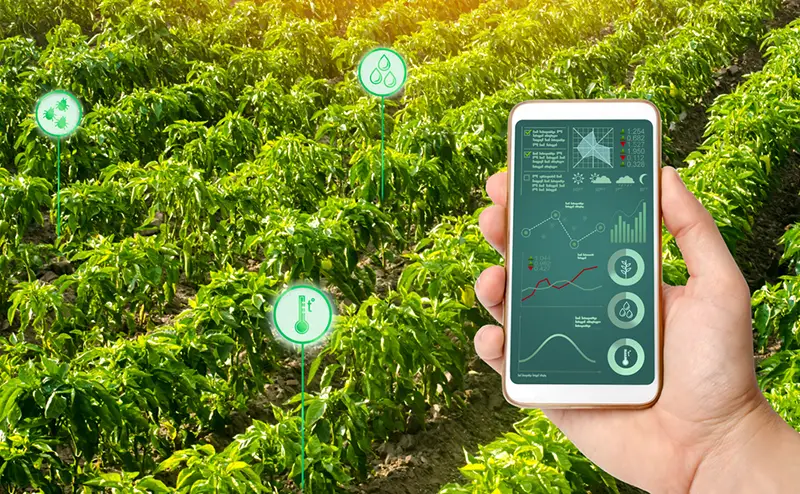Click here to get this post in PDF
Agriculture is gaining more and more popularity thanks to its growing profitability. Modern farmers are more like scientists from secret laboratories, as constant innovations make their work much more efficient. In recent years, the number of IT startups in agriculture has grown tremendously, and the use of new technologies is helping to harvest record yields while saving resources.
In this article, we will break down four main modern agribusiness technologies and methods that have become milestones of effective crop production and keep paving the way to producing food both efficiently and sustainably.
No-Till Farming
No-till farming is a modern technique of soil cultivation, in which the soil is not cultivated in the traditional, mechanical way by plowing, but is covered with mulch (crushed plant residues).
However, this soil treatment method should not be perceived simplistically, only as a rejection of plowing, since this method is, first of all, a complex technological model that requires both special knowledge, and the availability of highly qualified specialists and special equipment. Hence, a positive effect from its use can be obtained only by using an integrated and systematic approach.
Nevertheless, in practice, it has been proven that the use of no-till method can significantly reduce the cost of agricultural work, since it reduces labor costs and helps save a big part of expensive resources.
One of the key elements of the no-till system is crop rotation, and a large role in it is played by green manure, which not only improves the soil, but also plays an important role in weed control, replacing plowing in this aspect.
Fertilizers and pesticides in the no-till system are used no less widely than in traditional modern farming. More so, abandoning plowing may lead to an increase in the use of herbicides and other plant protection products.
The no-till system has a number of advantages over traditional tillage-based systems:
- Saves resources (fuel, fertilizers, labor costs, time, reduces depreciation costs)
- The cost savings significantly exceed the slight decrease in yield and, accordingly, the profitability increases
- Preservation and restoration of the fertile soil layer
- Reduction and prevention of soil erosion
- The accumulation of moisture in the soil, which is especially important in steppe conditions and, accordingly, a noticeable decrease in the dependence of the crop on weather conditions
- Increase in crop yields due to the above factors.
Organic Farming
Organic farming involves using special crop growing techniques that maximize the protection of the environment and nature. Producers of organic farming products use only biological substances to fertilize and protect their plants and crops. In particular, they use manure, compost, and special organic fertilizers. To protect against insects and pests, they use only traps and other animals. This approach to farming requires an impressive amount of effort and results in a significant decrease in yields. However, organic producers get the opportunity to sell products at a higher cost.
The main tasks of organic farming are:
- Production of safe and healthy food, free of agrochemicals
- General protection of the environment through balanced management
- Sustainable use of energy and natural resources (water, soil, organic matter)
- Maintenance and increase of soil fertility and biological activity
- Protection of farmers’ health from exposure to harmful chemicals.
- Ensurance of animal welfare
Precision Farming
In today’s world, there is an urgent need to produce more products at less cost. This is exactly what precision farming is developed for. This technology is revolutionizing traditional agricultural practices. The use of precision farming allows farmers to increase efficiency and productivity at every stage of agricultural work, optimize the amount of input materials, reduce costs, and increase yields.
With the introduction of precision technologies, the organization of agricultural production at an elementary site changes: precise seeding, differentiated fertilization, smart irrigation, etc. These changes are achieved through the automation of agricultural processes thanks to a variety of technologies like satellite farm monitoring, drones, ground devices, GPS-powered vehicles, and more. All of this tech allows for highest possible precision in all farm activities, enabling costs and resources saving. Many farms also integrate harvest management software into these systems to monitor yields, optimize timing, and track results for better decision-making season after season.
Bioengineering
Biotechnology is the integration of natural and engineering sciences, which makes it possible to fully realize the capabilities of living organisms or their derivatives for the creation and modification of products or processes for various purposes.
Biotechnology in agriculture is divided into three more popular areas: biotechnology in crop production (plant protection, increased productivity and early maturity), biotechnology in animal husbandry (survival of young animals, accelerated weight gain, increased resistance to diseases, increased milk yield), biotechnology in the field of waste disposal (poultry manure, cattle and pig waste, crop waste).
Plants, like animals, have innate defense mechanisms against various insects and diseases. Scientists are currently actively looking for compounds that would activate these natural mechanisms without harming the environment. Biotechnology also holds great promise in the development of new biopesticides, such as proteins of microorganisms and fatty acids that are toxic to certain pests but harmless to humans, animals, fish, birds, and beneficial insects.
Biotechnological methods also make it possible to increase the efficiency of the absorption of microelements by plants. Ultimately, agricultural biotechnology can make a decisive contribution to solving a number of human problems.
Overall, all these four milestones of crop production have already changed the way agriculture operates today. And with the growing world population and hence the food demand, these technologies will most likely keep gaining popularity among farmers globally to help them shift toward productivity and sustainability simultaneously.
You may also like: Is Your Business Truly Protected from Costly Environmental Exposures?
Image source: Depositphotos.com

